第三章国际收支
国际金融学重点
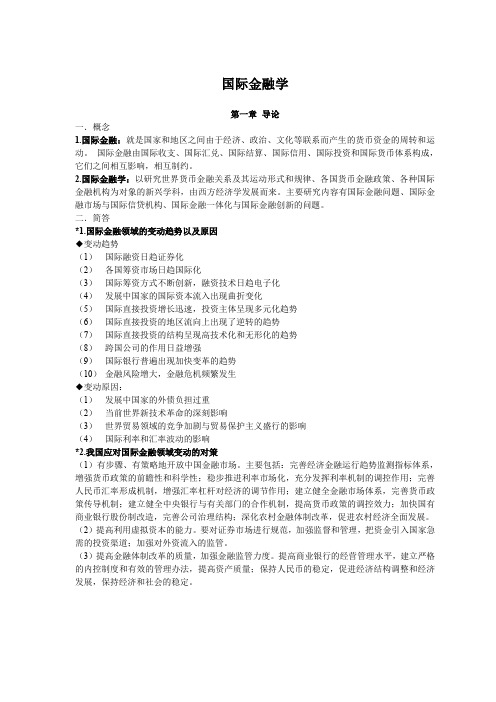
国际金融学第一章导论一.概念1.国际金融:就是国家和地区之间由于经济、政治、文化等联系而产生的货币资金的周转和运动。
国际金融由国际收支、国际汇兑、国际结算、国际信用、国际投资和国际货币体系构成,它们之间相互影响,相互制约。
2.国际金融学:以研究世界货币金融关系及其运动形式和规律、各国货币金融政策、各种国际金融机构为对象的新兴学科,由西方经济学发展而来。
主要研究内容有国际金融问题、国际金融市场与国际信贷机构、国际金融一体化与国际金融创新的问题。
二.简答*1.国际金融领域的变动趋势以及原因◆变动趋势(1)国际融资日趋证券化(2)各国筹资市场日趋国际化(3)国际筹资方式不断创新,融资技术日趋电子化(4)发展中国家的国际资本流入出现曲折变化(5)国际直接投资增长迅速,投资主体呈现多元化趋势(6)国际直接投资的地区流向上出现了逆转的趋势(7)国际直接投资的结构呈现高技术化和无形化的趋势(8)跨国公司的作用日益增强(9)国际银行普遍出现加快变革的趋势(10)金融风险增大,金融危机频繁发生◆变动原因:(1)发展中国家的外债负担过重(2)当前世界新技术革命的深刻影响(3)世界贸易领域的竞争加剧与贸易保护主义盛行的影响(4)国际利率和汇率波动的影响*2.我国应对国际金融领域变动的对策(1)有步骤、有策略地开放中国金融市场。
主要包括:完善经济金融运行趋势监测指标体系,增强货币政策的前瞻性和科学性;稳步推进利率市场化,充分发挥利率机制的调控作用;完善人民币汇率形成机制,增强汇率杠杆对经济的调节作用;建立健全金融市场体系,完善货币政策传导机制;建立健全中央银行与有关部门的合作机制,提高货币政策的调控效力;加快国有商业银行股份制改造,完善公司治理结构;深化农村金融体制改革,促进农村经济全面发展。
(2)提高利用虚拟资本的能力。
要对证券市场进行规范,加强监督和管理,把资金引入国家急需的投资渠道;加强对外资流入的监管。
(3)提高金融体制改革的质量,加强金融监管力度。
国际金融—国际收支
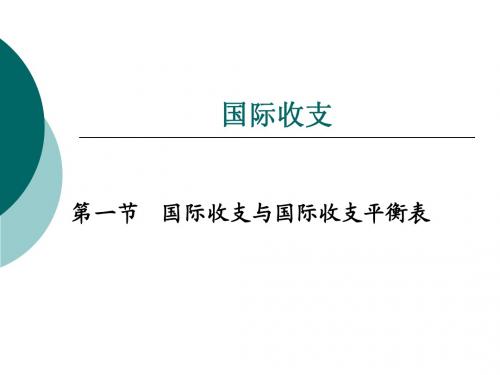
理论上讲,自主性交易的收入大于支出,即 为国际收支盈余;反之,则为国际收支赤字;收入 等于支持或自主性交易差额为零,则为国际收支平 衡。需要通过补偿性交易才达到的平衡,是形式上 的国际收支平衡和实际上的国际收支不平衡。
一、国际收支的盈余、赤字与平衡 国际收支的盈余、
国际收支账户汇总表
项目
1 商品 2 服务 3 收入 4 经常转移 5 资本转移 6 直接投资 7 证券投资 8 其他投资 9 储备资产 总计 2307 3+60 800 100 100 100+6+40+48 1000 40 3+800 48 2307
借方(万元) 借方(万元)
1000+50
贷方(万元) 贷方(万元)
一、国际收支的概念
(3) IMF的国际收支定义 IMF的国际收支定义 国际收支是指在一定时期内(一年、一季度、 一月)一国(或地区)居民与非居民之间全部经济 交易的货币价值的系统记录。这是所谓“广义的国 “ 际收支” 际收支”概念。 以交易为基础的“广义的国际收支”概念比以 “广义的国际收支” 支付为基础的“狭义的国际收支”概念更符合二战 “狭义的国际收支” 以来国际经济交易活动的实际状况。
二、国际收支平衡表
1、基本原理 国际收支平衡表是指一国在一定时期内(一 年、一季度、一月)将其国际收支按照特定账户分 类和复式簿记原理进行反映的报表。 根据IMF最新出版的《国际收支手册》第五版, 其账户分类如下:
二、国际收支平衡表
(1)账户分类 A.经常账户:是指对实际资源在居民与非居民之间的 流动进行记录的账户,它包括:商品、服务、收入、 经常转移。 a.商品: 记录商品的进出口,即有形贸易。出口记贷方, 进口记借方,按离岸价格(FOB)计价。 b.服务: 记录运输、旅游、通讯、金融、保险等服务的 输入输出,即无形贸易。输出记贷方,输入记借方。
武大国际经济学名词解释

第一章国际收支●国际收支:是在一定时期内一国居民对其他国家居民所进行的全部经济交易的系统记录。
国际收支分文狭义和广义的概念:狭义上是指一国的外汇收支,即凡是在国际经济交易中必须通过外汇收支进行清算的交易,都属于国际收支的内容。
广义上指不涉及外汇收支的各种经济交易,如清算支付协定项目上的记帐、易货贸易等也包括在内。
●国际收支平衡表(Balance of Payments Statements)也叫国际收支账户,是一国将其一定时期内的全部国际经济交易,根据交易的内容与范围,按照特定账户分类和复式记账原理表示的会计报表。
●经常账户(Current Account)又称为往来账户,反映了一个经济体与其他经济体之间真实资源的转移情况,并在整个国际收支账户中占主要地位。
具体包括货物、服务、收益和经常转移等四个子账户。
●货物(Goods)。
包括一般商品、用于加工的货物、货物修理、各种运输工具在购买的货物和非货币黄金。
IMF建议,货物按边境的离岸价格(FOB)计价。
●服务(Services)。
包括运输、旅游、通讯、建筑、金融、保险、计算机和信息服务、专有权的使用费和特许费以及其他商业服务。
●收益(Income)。
包括居民和非居民之间的两大类交易:一是职工报酬,主要指支付给非居民工人(如季节性的短期工人)的工资报酬。
二是投资收益,包括直接投资、证券投资和其他投资的收入和支出,以及储备资产的收入。
●经常转移(Current Transfer)。
是排除了以下资产所有权转移的单方面价值转移:一是固定资产所有权的转移;二是同固定资产收买/放弃相联系或以其为条件的资产转移;三是债权人不索取任何回报而取消的债务。
经常转移包括各级政府的转移(如政府间经常性的国际合作、对收入和财政支付的经常性税收等)和其他转移(如工人汇款)。
●资本和金融账户(Capital and Financial Account)主要反映资本所有权在一国与其他国家之间的移动,即国际资本流动。
国际金融复习大纲
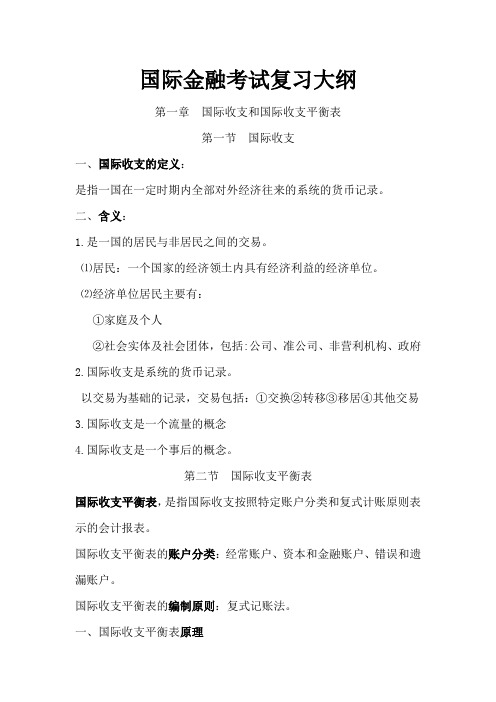
国际金融考试复习大纲第一章国际收支和国际收支平衡表第一节国际收支一、国际收支的定义:是指一国在一定时期内全部对外经济往来的系统的货币记录。
二、含义:1.是一国的居民与非居民之间的交易。
⑴居民:一个国家的经济领土内具有经济利益的经济单位。
⑵经济单位居民主要有:①家庭及个人②社会实体及社会团体,包括:公司、准公司、非营利机构、政府2.国际收支是系统的货币记录。
以交易为基础的记录,交易包括:①交换②转移③移居④其他交易3.国际收支是一个流量的概念4.国际收支是一个事后的概念。
第二节国际收支平衡表国际收支平衡表,是指国际收支按照特定账户分类和复式计账原则表示的会计报表。
国际收支平衡表的账户分类:经常账户、资本和金融账户、错误和遗漏账户。
国际收支平衡表的编制原则:复式记账法。
一、国际收支平衡表原理(一)账户分类1.经常账户:①货物②服务③收入④经常转移2.资本与金融账户①资本账户:含资本转移及非生产、非金融资产的收买与放弃②金融账户:含直接投资、证券投资、其他投资、官方储备3.错误与遗漏账户(二)复式记账方法1.借方和贷方2.借方记录资金的使用和占用,贷方记录资金的来源3.汇总后正余额表示顺差(盈余),负余额表示逆差(赤字)。
(三)记账货币国际收支平衡表账户分类二、国际收支平衡表的复式记账法1.任何一笔交易发生,必然涉及借方和贷方两个方面,有借必有贷,借贷必相等。
2.借方记录的是资金的使用(譬如用于进口外国商品,或购买外国金融资产),贷方记录的是资金的来源(譬如通过出口本国商品而获得资金,或从外国获得收入,或出售外国金融资产)。
3.将各个科目的记录汇总后,正余额意味着该科目的顺差(或盈余),负余额意味着该科目的逆差(或赤字)。
实例:中国的国际收支平衡表1.从复式记账法的原则来看:经常项目差额+资本和金融项目差额=储备资产变动+净误差和遗漏。
2.我国国际收支顺差的主要来源是经常项目下的进出口差额与资本和金融项目下的外国直接投资。
第三章 国际收支账户和国际支付体系

§3 国际收支的会计原理
④本国居民收到的国外的单方面转移, 记入贷方(+) 本国居民对非居民的单方面转移, 记入借方(-)
⑤官方储备减少,记入贷方(+) 官方储备增加,记入借方(-)
§3 国际收支的会计原理
3、凡属于下列情况均应记入贷方: (1)向外国提供商品或劳务(出口);(2)外国人 提供的捐赠与援助;(3)国内官方当局或私人放 弃国外资产或国外负债的增加;(4)官方储备的 减少。 凡属于下列情况均应记入借方: (1)从外国获得的商品和劳务(进口);(2)向外 国政府或私人提供的援助、捐赠等;(3)国内官 方当局或私人的国外资产的增加或国外负债的减 少;(4)官方储备的增加。
(其他例题:见书上P96)
国际收支的记帐练习
(注:以下各例中的本国均指美国,编制美国的 BPS分录记帐) [例1]本国企业运用其在国外银行的存款进口50万 美元的设备。 [例2]本国向外国出口60万美元的货物,货款三月 后才能到,但三月后收回债权时正好是下一个 编表年度。 [例3]本国政府动用外汇储备40万美元和70万美元 的药品向外国提供援助 。 [例4]本国企业将其在国外获得的投资利润200万 美元进行再投资,以扩大对外直接投资规模。
问题:以下交易分别属于借方还是贷方项目? 进口货物;出口货物 非居民向居民提供服务;居民向非居民提供 服务 非居民从本国取得收入;居民从外国取得收 入 居民对非居民提供单方面转移;非居民对居 民提供单方面转移 居民获得外国资产;非居民获得本国资产 居民偿还非居民的债务;非居民偿还居民的 债务 官方储备资产增加;官方储备资产减少
判断居民的小练习
*某中国人移民到美国,属于( )居民。 *我国驻美大使或外交人员,属于( )非居 民。 *IBM在中国的分公司,属于( )居民。 *我国的驻俄罗斯大使馆,属于( )居民。 *国际货币基金组织,属于( )非居民。
国际金融名词解释
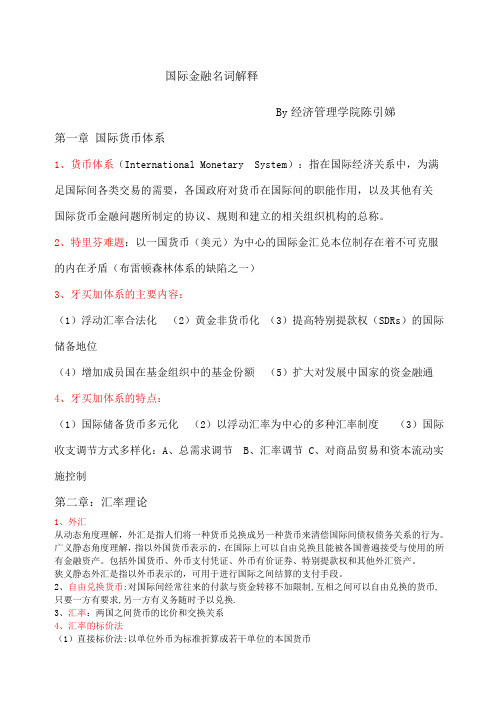
国际金融名词解释By经济管理学院陈引娣第一章国际货币体系1、货币体系(International Monetary System):指在国际经济关系中,为满足国际间各类交易的需要,各国政府对货币在国际间的职能作用,以及其他有关国际货币金融问题所制定的协议、规则和建立的相关组织机构的总称。
2、特里芬难题:以一国货币(美元)为中心的国际金汇兑本位制存在着不可克服的内在矛盾(布雷顿森林体系的缺陷之一)3、牙买加体系的主要内容:(1)浮动汇率合法化(2)黄金非货币化(3)提高特别提款权(SDRs)的国际储备地位(4)增加成员国在基金组织中的基金份额(5)扩大对发展中国家的资金融通4、牙买加体系的特点:(1)国际储备货币多元化(2)以浮动汇率为中心的多种汇率制度(3)国际收支调节方式多样化:A、总需求调节 B、汇率调节 C、对商品贸易和资本流动实施控制第二章:汇率理论1、外汇从动态角度理解,外汇是指人们将一种货币兑换成另一种货币来清偿国际间债权债务关系的行为。
广义静态角度理解,指以外国货币表示的,在国际上可以自由兑换且能被各国普遍接受与使用的所有金融资产。
包括外国货币、外币支付凭证、外币有价证券、特别提款权和其他外汇资产。
狭义静态外汇是指以外币表示的,可用于进行国际之间结算的支付手段。
2、自由兑换货币:对国际间经常往来的付款与资金转移不加限制,互相之间可以自由兑换的货币,只要一方有要求,另一方有义务随时予以兑换.3、汇率:两国之间货币的比价和交换关系4、汇率的标价法(1)直接标价法:以单位外币为标准折算成若干单位的本国货币(2)间接标价法:以单位本币为标准折算成若干单位的外国货币(3)美元标价法:以一定单位的美元为标准来计算应该兑换多少其他国家货币的汇率表示方法5、汇率按照经济意义分类(1)名义汇率:某一市场的汇率或官定汇率.(2)实际汇率:是以相同货币计量外国商品和本国商品的比率(3)有效汇率:是各种双边汇率的加权平均.A 币有效汇率=∑A 国货币对i 国货币的汇率×(A 国同i 国的贸易值/A 国的全部对外贸易值)6、影响汇率变动的主要因素(1)长期因素A 、经常帐户差额B 、通货膨胀率的差异C 、经济增长率差异 a.收入和进口 b.生产率 c.资本流入(2)短期因素A 、利率差异B 、信息的获取或捕捉C 、政府对外汇市场的干预D 、人们的心理预期E 、宏观经济政策a.逆差时会实行(双紧的政策)b.货币政策中的货币供应量增加-本币贬值7、汇率变动对国民经济的影响(1)对国际收支的影响(以贬值为例)A 、对进出口贸易收支B 、对非贸易收支(旅游和劳务的出口增加,进口减少)C 、对国际资本流动(对影响长期资本影响不大)——(汇率预期会影响短期资本)(2)对国内经济的影响(以贬值为例)A 、物价效应(a.出口增加而引起的抢购 b.进口价上升而引起的攀比 c.原材料价格的上升 d.会影响一国的宏观经济总量用外币表示的规模)B 、收入分配效应(出口商,进口商,国外的进口商收入增加)C 、产业结构(出口和进口替代品会获得发展)D 、就业率(增加,但条件是工资不变或变动幅度小于汇率变动的幅度)(3)贬值对国际经济的影响A 、小国货币贬值:会影响邻国和贸易伙伴国B 、大国货币贬值:a.工业大国主要是进口国,贬值会使其进口减少b.汇率大战,贸易大战c.国际储备体系金融体系的动荡8、购买力平价理论:该理论产生于第一次世界大战刚刚结束时期,是世界经济动荡不安的产物。
跨国商业金融第十四版第三章国际收支平衡
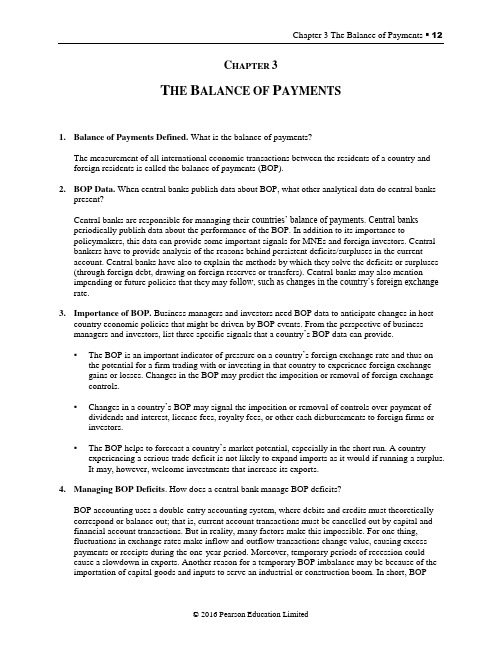
C HAPTER 3T HE B ALANCE OF P AYMENTS1. Balance of Payments Defined. What is the balance of payments?The measurement of all international economic transactions between the residents of a country and foreign residents is called the balance of payments (BOP).2. BOP Data. When central banks publish data about BOP, what other analytical data do central bankspresent?Central banks are responsible for managing their countries’ balance of payments. Central banksperiodically publish data about the performance of the BOP. In addition to its importance topolicymakers, this data can provide some important signals for MNEs and foreign investors. Central bankers have to provide analysis of the reasons behind persistent deficits/surpluses in the current account. Central banks have also to explain the methods by which they solve the deficits or surpluses (through foreign debt, drawing on foreign reserves or transfers). Central banks may also mention impending or future policies that they may fo llow, such as changes in the country’s foreign exchange rate.3. Importance of BOP. Business managers and investors need BOP data to anticipate changes in hostcountry economic policies that might be driven by BOP events. From the perspective of business managers and investors, list three specific signals that a country’s BOP data can provide.▪The BOP is an important indicator of pressure on a country’s foreign exchange rate and thus on the potential for a firm trading with or investing in that country to experience foreign exchangegains or losses. Changes in the BOP may predict the imposition or removal of foreign exchangecontrols.▪Changes in a country’s BOP may signal the imposition or removal of controls over payment of dividends and interest, license fees, royalty fees, or other cash disbursements to foreign firms orinvestors.▪The BOP helps to forecast a country’s market potential, especially in the short run. A country experiencing a serious trade deficit is not likely to expand imports as it would if running a surplus.It may, however, welcome investments that increase its exports.4. Managing BOP Deficits. How does a central bank manage BOP deficits?BOP accounting uses a double-entry accounting system, where debits and credits must theoretically correspond or balance out; that is, current account transactions must be cancelled out by capital and financial account transactions. But in reality, many factors make this impossible. For one thing,fluctuations in exchange rates make inflow and outflow transactions change value, causing excess payments or receipts during the one-year period. Moreover, temporary periods of recession could cause a slowdown in exports. Another reason for a temporary BOP imbalance may be because of the importation of capital goods and inputs to serve an industrial or construction boom. In short, BOPdeficits are not necessarily a bad phenomenon in their own right, but must be analyzed within the broader macroeconomic picture.5. Economic Activity. What data can a nation’s BOP provide about a country’s economy?Reading through the BOP can provide detailed information about the performance of the country on international markets and the economic competitiveness of its forms. If a country is experiencing recurrent current account deficits, this may be an indication of the lack of competitiveness of the country’s industries. Recurrent capital account deficits may signal increasing public expenditures and fiscal budget deficits. It can also signal protectionist policies that the government may be following.6. Balance. If the BOP always “balances,” then how do countries run a BOP deficit or surplus?The cumulative international economic transactions of the BOP should balance. These include the three main component accounts: current account, capital account, and financial account, in addition to the statistical discrepancies and official reserves. But each of the three component accounts can either show a deficit or a surplus. Countries run BOP deficits when their outflows are higher than their inflows and vice versa. A BOP deficit can be supported by drawing on reserve holdings or byborrowing from abroad. Conversely, an overall BOP surplus is absorbed by adding to the central bank’s reserve holdings or by making foreign loans.7. Official Reserve Account. Why does the central bank of a nation hold official reserve assets? Whatare its major components?Official reserve assets are financial assets held by monetary authorities such as central banks. These should be highly liquid assets in the form of foreign currencies, gold, precious metals, specialdrawing rights (SDRs), and reserve positions with the IMF. The most important foreign currency reserves are the US dollar and the euro, followed by the British pound and the Japanese yen. Official reserves are used as international means of payments to finance trade imbalances, determine the exchange rate of the domestic currency, and influence the money supply.8. Current Account Surpluses. Explain the main causes behind the current account surpluses thatAsian emerging economies have maintained during the last two decades.Asian emerging economies have maintained a current account surpluses for the last two or three decades. This is mainly due to the fact that their economic growth strategies are dependent onexport-oriented policies. These policies include a devaluated domestic currency that provides more competitiveness for local industries and restricts imports. At the same time, the relatively closed nature of Asian emerging ma rkets hampers foreigners’ exports. These protectionist policies have created a continuous current account surplus. But it may not be favorable to maintain in the long-run since they will eventually lead to exchange rate appreciation and deterioration in the terms of trade.9. BOP Accounting Deficits. BOP Accounting Deficits. A deficit in the BOP is not necessarily a badthing, but must be analyzed in relation to the business cycle and economy. Explain.BOP deficits arise when the total level of outflows exceeds inflows. In the short run, central banks take out loans in order to make the BOP balance out. But long-term remedies to correct a balance of payment disequilibrium lies in adopting monetary, institutional, and fiscal policy changes to earn more foreign exchange from boosting exports and/or reducing imports.10. Current Account. Is the current account the same as the balance of trade (BOT)? Give debit andcredit examples of current account and BOT transactions by a German automobile MNE.The current account is one of the sub-component accounts of the BOP. It comprises the goods trade account (exports and imports of tangible goods); services trade account (exports and imports of intangible services); income account (current investment income as well as wages/salaries of non-resident workers; and current transfers account (personal or corporate financial settlements and inter-country gift and grant transfers. The largest sub-account of the current account is the Balance of Trade (BOT), which makes up the goods and services trade balances. It is generally the most quoted of all BOP accounts.The following are examples of transactions of an automobile MNE headquartered in Germany and operating in many countries.11. Negative Net International Investment Position. What does a country’s consistent nega tive netinternational investment position indicate?The net international investment position (NIIP) is the difference between the accumulated stock of the country’s claims on foreigners and the accumulated stock of foreign claims on domestic residents.The NIIP can be thought of as a nation’s international balance sheet. The accumulated stock and liabilities include assets such as shares, bonds, private assets, direct investment (such as subsidiaries and branches in foreign countries), bank loans, trade credits, official reserve assets, and government assets (such as foreign treasury bills).When claims of foreigners on the country are greater than domestic claims on foreigners, thisrepresents the net foreign indebtedness of the country. One reason for this deficit is foreignborrowings, mainly to service debts or to finance current account deficits. Another reason could be that domestic investors prefer to include foreign financial instruments in their portfolio because of higher rates of return on assets held abroad in comparison to domestic rates of return. Negative NIIP could be the result of fluctuations in asset prices and/or exchange rates.12. BOP and foreign exchange. The Swiss franc was officially unpegged from the euro in January 2015.Explain the reason behind this decision with reference to the Swiss BOP.The Swiss National Bank (SNB) pegged the Swiss franc against the euro in 2011 amid shaky global financial markets. Exports had already boomed, making up almost 70% of GDP. As the currentaccount enjoyed a substantial surplus, the SNB accumulated massive foreign reserves. As the euro kept weakening due to the sovereign debt problems of Greece and Spain, the franc automatically depreciated, raising alarm bells that it would no longer be a safe and stable currency. In response, the SNB decided to unpeg the franc, causing an instant appreciation. The stronger franc will help reduce the current account surplus.13. Classifying Transactions. Classify the following as a transaction reported in a sub-component of thecurrent account or the capital and financial accounts of the two countries involved:a. A U.S. food chain imports wine from Chile. Debit to U.S. goods part of current account, credit toChilean goods part of current account.b. A U.S. resident purchases a euro-denominated bond from a German company. Debit to U.S.portfolio part of financial account; credit to German portfolio of financial account.c. Singaporean parents pay for their daughter to study at a U.S. university. Credit to U.S. currenttransfers in current account; debit to Singapore current transfers in current account.d. A U.S. university gives a tuition grant to a foreign student from Singapore. If the student isalready in the United States, no entry will appear in the balance of payments because payment is between U.S. residents. (A student already in the United States becomes a resident for balance of payments purposes.)e. A British Company imports Spanish oranges, paying with eurodollars on deposit in London. Adebit to the goods part of Britain’s current account; a credit to the goods part of Spain’s currentaccount.f. The Spanish orchard deposits half the proceeds in a eurodollar account in London. No recordingin the U.S. balance of payments, as the transaction was between foreigners using dollars already deposited abroad. A debit to the income receipts/payments of the British current account; a credit to the income receipts/payments of the Spanish current account.g. A London-based insurance company buys U.S. corporate bonds for its investment portfolio. Adebit to the portfolio investment section of the British financial accounts; a credit to the portfolio investment section of the U.S. balance of payments.h. An American multinational enterprise buys insurance from a London insurance broker. A debit tothe services part of the U.S. current account; a credit to the services part of the British currentaccount.i. A London insurance firm pays for losses incurred in the United States because of an internationalterrorist attack. A debit to the services part of the British current account; a credit to the services part of the U.S. current account.j. Cathay Pacific Airlines buys jet fuel at Los Angeles International Airport so it can fly the return segment of a flight back to Hong Kong. Hong Kong keeps its balance of payments separate from those of the People’s Republic of China. Hence a debit to the goods part of Hong Kong’s current account; a credit to the goods part of the U.S. current account.k. A California-based mutual fund buys shares of stock on the Tokyo and London stock exchanges.A debit to the portfolio investment section of the U.S. financial account; a credit to the portfolioinvestment section of the Japanese and British financial accounts.l. The U.S. army buys food for its troops in South Asia from vendors in Thailand. A debit to the goods part of the U.S. current account; a credit to the goods part of the Thai current account.m. A Yale graduate gets a job with the International Committee of the Red Cross working in Bosnia and is paid in Swiss francs. A debit to the income part of the Swiss current account; a credit to the income part of the Bosnia current account. This assumes the Yale graduate spends her earnings within Bosnia; should she deposit the sum in the United States, then the credit would be to the income part of the U.S. current account.n. The Russian government hires a Dutch salvage firm to raise a sunken submarine. A debit to the service part of Russia’s current account; a credit to the service part of the Netherlands’s current account.o. A Colombian drug cartel smuggles cocaine into the United States, receives a suitcase of cash, and flies back to Colombia with that cash. This would not get captured in the goods part of the U.S. or Colombian current accounts. Assuming the cash was “laundered” appropriately, from the point of view of the smugglers, bank accounts in the United States or somewhere else (probably notColombia, possibly Switzerland) would be credited. This imbalance would end up in the errors and omissions part of the U.S. balance of payments.p. The U.S. government pays the salary of a Foreign Service Officer working in the U.S. embassy in Beirut. Diplomats serving in a foreign country are regarded as residents of their home country, so this payment would not be recorded in any balance of payments accounts. If or when the diplomat spent the money in Beirut, at that time a debit should be incurred in the goods or services part of the U.S. current account and a contrary entry in the Lebanon balance of payments. It is doubtful that the goods or services transaction would get reported or recorded, although on a net basis changes in bank balances would reflect half of the transaction.q. A Norwegian shipping firm pays U.S. dollars to the Egyptian government for passage of a ship through the Suez Canal. If the Norwegian firm paid with dollar balances held in the United States and the Suez Canal Authority of Egypt redeposited the proceeds in the United States, no entry would appear in the U.S. balance of payments. Norway would debit a purchase of services, and Egypt would credit a sale of services.r. A German automobile firm pays the salary of its executive working for a subsidiary in Detroit.Germany would record a debit in the income payments/receipts in its current account; the U.S.would record a credit in the income payments/receipts in its current account.s. An American tourist pays for a hotel in Paris with his American Express card. A debit would be recorded in the services part of the U.S. current account; a credit would be recorded in theservices part of the French current account.t. A French tourist from the provinces pays for a hotel in Paris with his American Express card. A French resident most likely has a French-issued credit card, issued by the French subsidiary of American Express. In this instance, no entry would appear in either country’s balance ofpayments. If, later, the French subsidiary of American Express paid a dividend back to the United States, that would be recorded in the income part of the current accounts.u. A U.S. professor goes abroad for a year and lives on a Fulbright grant. The current transfers section of the U.S. current account would be debited for the salary paid to a foreign resident.(Even though an American, the professor is a foreign resident during the time he lives abroad.) The current transfers section of the host country’s current account would be credited.14. Current Account Deficits. A deficit on the current account increases foreign liabilities. Explain whythis is more of a concern to the Eurozone than a country like Brazil.Brazil is one of the fastest growing emerging market economies. It is a newly industrialized nation where a substantial volume of its imports consists of inputs and intermediate goods needed formanufacturing. This results in a deficit in its current account. This is of little concern to Brazil since it anticipates continuous GDP growth as well as future growth of its exports. In order to restore its competitiveness on international markets, the Brazilian government occasionally resorts to devaluing the Brazilian real. On the other hand, the Eurozone’s current account deficits are causing highconcerns. One reason is that these economies have been growing at sluggish rates since the financial meltdown. Also, since Eurozone countries have a common currency, they are unable to individually devalue the euro to restore their competitiveness.15. Twin Surpluses. Why is China’s twin surpluses—a surplus in both the current and financialaccounts—considered unusual?China’s surpluses in both the current and financial accounts—termed the twin surplus in the business press—is highly unusual. Ordinarily, countries experiencing large current account deficits fund these deficits through equally large surpluses in the financial account, and vice versa.China has experienced a massive current account surplus and a sometimes sizable financial account surplus simultaneously. This is rare and an indicator of just how exceptional the growth of theChinese economy has been. Although current account surpluses of this magnitude would ordinarily create a financial account deficit, the positive prospects of the Chinese economy have drawn such massive capital inflows into China in recent years that the financial account too is in surplus.16. Treasury bonds. After the Global Financial Crisis especially sovereign and portfolio investors fromemerging market economies have purchased significant volumes of European treasury bonds. Discuss the impact on the European BOPs in both the short run and the long run.As foreigners purchase European treasury bonds, European BOP will improve in the short run. But in the long run, the BOP may deteriorate because European nations should make interest and principal payments to foreigners. However, if the European governments use these funds prudently andproductively, the long-term effect would be favorable to GDP and may even contribute to European firms’ competit iveness, eventually leading to long-run BOP improvements.17. Capital Mobility — The Eurozone. Low interest rates should normally lead to capital outflows toother countries and currencies in the search for higher interest rates. Explain why the opposite has occurred in the Eurozone.In spite of the remarkably low interest rates paid by the euro, capital has not flowed out of the Euro zone. In fact, the opposite has occurred as a result of high levels of productive innovation andperceived political stability. Moreover, the advanced level of financial services, technology,infrastructure and purchasing power are attractive to investors. All of these factors have made the Euro zone an attractive investment hub.18. BOP Transactions. Identify the correct BOP account for each of the following transactions.a. A German-based pension fund buys U.S. government 30-year bonds for its investment portfolio.Financial account: portfolio investment liabilitiesb. Scandinavian Airlines System (SAS) buys jet fuel at Newark Airport for its flight to Copenhagen.Current account: Goods: Exports FOBc. Hong Kong students pay tuition to the University of California, Berkeley.Current account: Services: creditd. The U.S. Air Force buys food in South Korea to supply is air crews.Current account: Goods: Importse. A Japanese auto company pays the salaries of its executives working for its U.S. subsidiaries.Current account: Services: creditf. A U.S. tourist pays for a restaurant meal in Bangkok.Current account: Services: debitg. A Colombian citizen smuggles cocaine into the United States, receives cash, and smuggles thedollars back into Colombia.Unrecorded but should be a current account item.h. A U.K. corporation purchases a euro-denominated bond from an Italian MNE.Does not enter the U.S. balance of payments19. BOP and Inflation. What are the direct and indirect relationships between the balance of paymentsand inflation?The current account and the level of imports have the potential to lo wer or raise a country’s inflation rate. If the inflation rate in the exporting country rises, then imported inflation will result. Moreover, if the domestic currency devalues, imported goods and services will become more expensive. On the other hand, imports of cheaper goods and services place pressures on domestic competitors to reduce the prices of comparable goods and services. Thus, the components and price levels of the imports (as appearing on the current account) can substantially impact prices, especially in import-orientedeconomies.20. J-Curve Dynamics. What is the J-Curve adjustment path?A country’s trade balance may change as a result of an exchange rate change in the shape of aflattened “j.” International economic analysis characterizes the trade balance adjustment process as occurring in three stages: (1) the currency contract period, (2) the pass-through period, and (3) the quantity adjustment period. Assuming that the trade balance is already in deficit prior to thedevaluation, a devaluation may actually result in the trade balance first worsening before improving as a result of the three distinct commercial periods.21. Pass Through. Explain the exchange rate pass through and whether it always holds true.Exchange rate pass through indicates the degree to which importers and exporters adjust the prices of goods and services according to exchange rate changes. Theoretical research such as the theory of PPP stipulates that all exchange rate changes are passed through by equivalent changes in prices to trading partners. However, empirical research has challenged this long-held postulation. For example, the sizable current account deficits of the United States and some European nations in the 1980s and 1990s did not show responses to changes in the exchange rate values.22. Restrictions on Capital Mobility. What factors seem to play a role in a government’s choice torestrict capital mobility?There is a spectrum of motivations for capital controls, with most associated with either insulating the domestic monetary and financial economy from outside markets or political motivations overownership and access interests. Capital controls are just as likely to occur over capital inflows as they are over capital outflows. Although there is a tendency for a negative connotation to accompany capital controls (possibly the bias of the word “control” itself), the impossible trinity requires that capital flows be controlled if a country wishes to maintain a fixed exchange rate and an independent monetary policy.23. Dutch Disease. Can controls of capital inflow solve the Dutch Disease in resource-rich countries?The economies of resource-rich countries can suffer from serious problems in the case of excessive capital inflows. In freely floating foreign exchange systems, massive capital inflows can lead toconsiderable currency appreciation. This phenomenon has come to be known as the Dutch Disease as it was first witnessed by the Netherlands in the 1970s after the discovery of the Groningen natural gas field. A stronger domestic currency may harm exporters as it lowers price competitiveness. Many oil-rich nations in Africa and Asia that have export sectors suffer from this problem. To tackle thisproblem, the government can place restrictions and controls on capital inflows. Another solution that some Gulf nations in the Arab peninsula resort to is to peg their currencies.24. Globalization and Capital Mobility. How does capital mobility typically differ betweenindustrialized countries and emerging market countries?Emerging market countries, by definition, have relatively small and undeveloped financial systems and sectors. Outside of some potential foreign direct investment opportunities, they offer few choices for capital to flow in of substance. Industrialized countries, however, typically have large andsophisticated financial sectors that offer a multitude of financial investment options and assets, which on occasion may attract large capital inflows (and in other periods, may suffer large capital outflows).。
国际金融名词解释

《国际金融》名词解释第一章外汇与汇率名词解释1)我国对外汇的定义:按照《中华人民共和国外汇管理条例》的定义,外汇是指下列以外币表示的可以用作国际清偿的支付手段和资产,具体包括:(1)外国货币,包括纸币、铸币;(2)外币支付凭证,包括票据、银行存款凭证、邮政储蓄凭证等;(3)外币有价证券,包括政府证券、公司证券、股票等;(4)特别提款权SDRs、欧洲货币单位ECU;(5)其他外汇资产,主要是指各种外币投资收益,比如股息、利息、债息、红利等。
2)直接标价法:又称应付标价法。
指以一定的外国货币为标准,折算为一定数额的本国货币来表示其汇率。
3)间接标价法:又称应收标价法。
指以一定单位的本国货币为标准,折算为一定数额的外国货币来表示其汇率。
4)远期汇率:指买卖双方成交后,在约定的日期办理交割时采用的汇率。
5)自由浮动:或称清洁浮动,是指一国货币当局对汇率的波动不进行任何干预,而完全任由汇率依外汇市场的供求变化而自由波动。
第二章外汇交易名词解释1)外汇期货:外汇期货交易是指交易双方在交易所内通过公开竞价的方式成交后,承诺在未来某一日期以约定的汇率(一般以美元报价)交割特定标准数量某种外汇的活动。
2)套期保值:指在有远期负债/资产的情况下,买进/卖出币种相同、金额相等、期限一样的外汇,避免该货币的汇率变动风险,达到保值的目的。
3)外汇期权交易:指期权购买者向期权出售者支付一定比例的费用(期权费)之后,即可在期权有效期内按协定汇率履行或放弃买卖一定金额某种外汇的一种外汇交易。
4)外汇期权:也称为货币期权,指合约购买方向出售方支付一定期权费之后,所获得的在未来约定日期或一定时间内,按照规定汇率买进或者卖出一定数量外汇资产的选择权。
第三章国际收支名词解释1)国际收支:(狭义)一个国家或地区在一定时期内,由于经济、政治、文化等各种对外交往而发生的,必须立即结清的外汇的收入与支出。
(广义)指一国或地区居民与非居民在一定时期内所进行的全部经济交易的系统记录,2)自主性交易:指经济实体或个人出自某种经济动机和目的独自进行的交易。
第3章 国际收支的平衡与调节
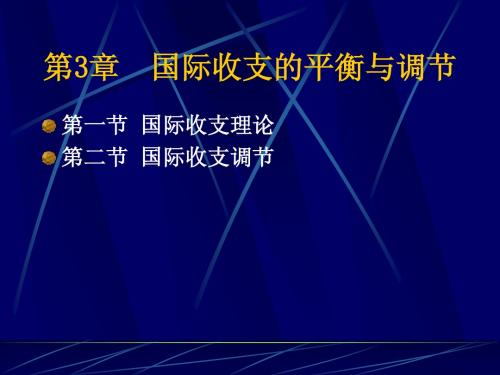
古典学派的国际收支自动调节理论-1
1、 特点:该理论是建立在货币数量论基础上,以金 本位制和自由贸易的存在为前提。 调节过程均涉及三个小环节,即黄金量多寡、物价高 低和进出口增减。 2、代表观点:休谟机制(物价-现金流动机制学说) 在金本位制度下,黄金的输出入,使外汇供求得到均 衡,并使汇率在一定范围内波动。但是无论任何国家, 如果其汇率继续维持在黄金输出点上,而黄金不断地 输出时,即使该国有巨额的黄金储备,它的黄金储备 终有枯竭的一天。 休谟认为,任何国家都不会发生黄金持续流出,以致 黄金储备流尽,而不能维持金本位制度的现象。这就 是“物价—现金流动机制”理论。这一思想,从1752 年至1914年间,先后受到亚当· 斯密、穆勒、马歇尔等 古典学派经济学家的发扬,而成为古典学派国际收支 调节理论的核心。
吸收论
评价 吸收分析法是建立在宏观的、一般均衡 的基础上的,比微观的、局部的弹性分析 法有所进步,并强调了政策配合的意义, 不过,它仍有不足之处,表现在: 第一,两点假设(贬值是出口增加的唯一因 素、生产要素转移机制平滑)不切实际; 第二,倾斜地以国际收支中的贸易项目为研 究对象,而忽视日益发挥重要作用的资本 项目,从而使其理论无法完满。
Y>A, B>0,国际收支顺差 Y<A, B<0,国际收支逆差 Y=A, B<0,国际收支平衡
2.对策分析 它与弹性分析理论一样都侧重于分析货 币贬值政策对国际收支逆差的影响。 当Y<A,国际收支逆差时, Y↑或A↓,或两者兼用。
具体应结合国内的经济状况来考虑:
所谓边际吸收倾向,是指每增加的单位 收入中用于吸收的百分比。 在货币贬值而引发价格上涨的情 况下,实际现金余额效应使得人们减少 消费或卖出金融资产。减少支出意味着 支出相对于收入的减少,人们卖出证券 将间接提高利率,抑制了企业投资与居 民消费。
第三章 国际收支
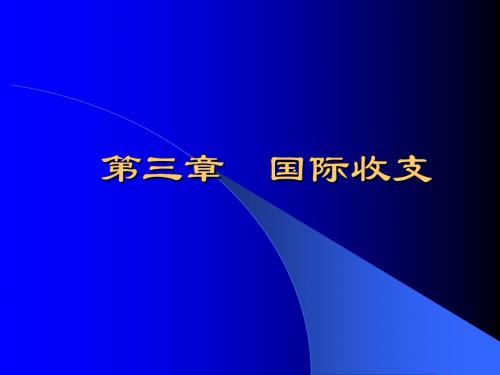
当今社会国际间贸易往来相当频繁,当用
货币支付贸易款项时,就产生了国际收支。 除此之外,国际间的经济、 政治、文化、 军事、体育等各个方面的往来也会产生国际收 支。
(二)国际收支的演化
狭义国际收支概念的出现: 国际收支概念最早起源于17世纪初。当时它等同 于一个国家的贸易收支差额。这是因为,在资本主义
国际收支衡量报告期内的每一笔对外经济 交易活动。一般以一年为报告期。
第二,国际收支所反映的内容是以货币 记录的经济交易。 4类经济交易:
1。交换 A商品服务与商品服务的交换 B金融资产与商品服务的交换 C金融资产之间的交换 2。转移 A商品服务由一方向另 一方转移 B金融资产由一方向另 一方转移
3。移居 4。其他交易,有些交易并没有发生资金或商品的国际流动 ,但可以根据推论确定居民与非居民之间交易的存在,也需 要在国际收支中记录。
但是,随着世界经济的发展,现有的国际收支概念越来越不 能全面反映一国的国际收支情况。特别是二战后,国际资本流动 规模越来越大,各国间的易货也司空见惯。此外,经常涉及单方 面的经济援助、军事援助、战争赔款等方方面面的转移,尤其是 美国。于是为适应国际经济发展的需要,如实地反映各国对外交 往的实际情况,国际收支的概念的范围和外延被不断扩大,并最 终使国际收支概念的表述建立在类似权责发生制的国际交易的基 础上。以交易为基础,既包括以实现外汇收支的交易,也包括尚 未实现外汇收支的交易,从而形成了广义的国际收支概念。
1。产权关系明晰,所有权和监护权明确,政企分开,有 一个自由竞争的市场环境。
2。经济主体最大限度的追求利益,从而使交换采用市场 交换的方式。企业是经济人,能够对价格信号作出反 应,能以获利为目的进行成本和收益分析。 3。存在健全的保护市场体系运行的法律制度,要有一套 保护市场经济运行的制度保障。 4。资源要素可以自由流动,商品和资本可自由输出入 5。政府在经济系统中扮演守业人角色,政府主要功能是 维护市场经济的有效运行。
第三章国际收支账户
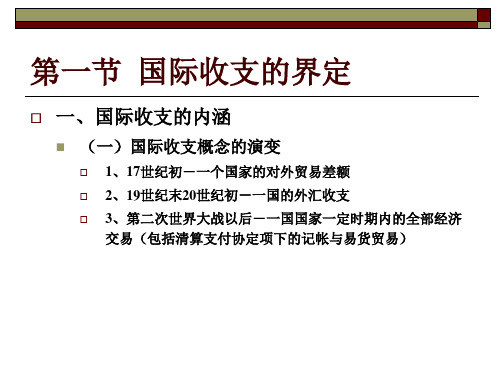
• 官方的短期对外借款或贷款可以缓冲收支不平衡对官方储备变 动的压力。
• 官方结算差额是政府用于平衡自发收支项目总差额的项目,它 衡量了一国货币当局所愿意弥补的国际收支差额。
• 官方结算顺差=官方储备净增额+对外国官方的流动负债净减额 官方结算逆差=官方储备净减额+对外国官方的流动负债净增额
1110 1420
差额
-890 -30 150 -100 -870
925 -40 -30 15 870
0
第四节 国际收支差额分项
一、国际收支平衡表的分析
➢ 纵向比较 ➢ 横向比较 ➢ 表内项目分析
✓ 逐项分析 ✓ 差额分析:商品贸易差额、经常账户差额、资本和金融账户
差额和总差额(总差额=经常账户差额+资本和金融账户差 额+错误和遗漏净值=储备账户变化)
本节练习题
1、由于一国的国际收支不可能正好收支相抵,因而国际 收支平衡表的最终差额绝不会为零。 错 根据复式记 账法,国际收支平衡表的余额恒为零。
2、经常账户和资本与金融账户都属于自主性交易账户。 错 资本与金融账户中的储备账户主要发生补偿性交易。
3、当一国出现经常账户赤字时,可以通过资本和金融账 户的盈余或者动用国际储备来为经常账户融资,因此无 需对经常账户的赤字加以调节。 错 长期经常账户赤字 表明本国国内实体经济运行存在问题,本国无法在长期 内吸引外国投资,用资本和金融账户盈余来为经常账户 的赤字融资,同时,本国的国际储备是有限的,也无法 无限制地动用国际储备来为经常账户融资,因此对于长 期经常账户赤字,有必要采取主动型的政策加以化解。
6、借记间接投资40万美元,贷记其他投资40万美元
国际金融学知识点

国际金融学知识点一、名词解释1.外汇:一国厂商经过以本国或兑换某种国际货币去清偿国际债务,就叫做国际汇兑,外汇是它的简称。
2.国际收支:国际收支简单解释为一具国家的对外贸易的差额。
及进口与出口之对照。
国际收支有广义和狭义之分。
广义的国际收支包括外汇收支的国际借贷关系,也包括没有实际实际外汇收支的经济交易,如私人和政府捐赠、无偿援助、易货贸易等,及囊括了一国在一定阶段内对外的全部经济交易;狭义的国际收支是指一具国家在一定阶段内(通常为一年)同其他国家举行经济政治和文化等往来所发生的外汇收支的总和。
3.简介标价法是以一定单位的本币为基础,来计算应收多少外币,因此又称为应收标价法;直截了当标价法是以一定单位的外币为基础,来计算应收多少外币,因此又称为对付标价法。
4.即期外汇交易:是指银行与其客户(或其他银行)之间的在外汇买卖成交后,原则上两个工作日内举行交割的外汇交易业务。
5.套利交易:又称利息套利或时刻套利。
它是指当两种货币的市场利率有差异,投资者将资金从利率高的国家移往利率低的国家,从而赚取利差收益的外汇交易。
分为补偿性套利和非补偿性套利。
6.期权:是一种能在将来某特定时刻内以特定价格买进或卖出一定数量的某种特定商品的权利。
7.特殊提款权:是国际货币基金组织创设的一种记账单位,它既别是真正的货币,也别能兑换黄金,而是由国际货币基金组织分配给会员国的一种使用资金的权利。
作为它们的原由提款权,及一般提款权的补充。
8.一般提款权:又称储备头寸,是指国际货币基金组织的成员国基金组织中所存放并可调用的头寸。
9.套汇:利用同一时间别同外汇市场的汇率差异,经过买进或卖出外汇而赚取收益的行为。
10.国际储备:一国政府所持有的被用于弥补国际收支赤字维持本国货币汇率的国际间能够同意的一切资产。
11.国际资本流淌:资本从一具国家或地区向另一具国家或地区转移。
12.外国债券:投资者在国外发行以当地货币为面值发行的债券。
13.贴现:指持票人未到期票据向银行兑换现金,银行将扣除从买进日到到期日的利息后的款项付给持票人。
第三章 汇率决定的原理(Ⅱ)

本国国民收入↑→进口↑→外汇需求↑→本币贬 值(直接标价法的汇率↑); 本国价格水平↑→实际汇率↑→本国产品竞争力 ↓→经常帐户恶化→本币贬值(实际汇率恢复原 状); 本国利率↑→资本流入→本币升值; 预期未来本币贬值→资本流出→本币即期贬值。
(3)对国际收支说的简单评价 第一,国际收支说指出了汇率与国际收支之间 存在的密切关系,有利于全面分析短期内汇率 的变动和决定; 第二,与购买力平价说及利率平价说一样,国 际收支说也不能被视为完整的汇率决定理论; 第三,国际收支说是关于汇率决定的流量理论, 因为它认为是国际收支引起的外汇供求流量决 定了短期汇率水平及其变动。
三、贬值对国际资本的影响
1、贬值对长期国际资本的影响 一般情况下,贬值会鼓励长期资本流入。因为一国汇率下 调,使得同样的国外投资可购得比以前更多的生产资料和劳务, 从而有利于吸引外商到该国进行投资和追加投资。不过,在即 定利润率的条件下,汇率下跌也使得外商汇回母国的利润减少, 因而也可能出现不愿追加投资或抽回资本的情况。因此,一国 货币汇率下跌能否真正达到吸引外资的目的,还取决于外商在 汇率下跌前后获利大小的比较,以及贬值后是否造成经济状况 恶化、货币发生危机的可能性等因素的影响。 2、贬值对短期资本流动的影响 一般来说,贬值会导致短期资本外逃。短期资本逐利性强、 流动性大,尤其游资,极具投机性,因此,一旦贬值使金融资 产的相对价值降低,短期资本就会抽逃,同时,贬值还会造成 一种通货膨胀预期,影响实际利率水平,打破“利息平价”关 系,诱发投机性资本外逃。
二、贬值对国内物价的影响
贬值会给一国通货膨胀带来压力,引起物价上涨。 1、从进口来看,贬值导致进口商品价格上升,若进口的 多是原材料、中间产品,且这些物品弹性小,必然导致进 口成本的提高,由此引发成本推进型通货膨胀。 2、从出口来看,贬值会刺激出口,但若贬值的前提是国 内经济状况不好,则在短期内会加剧国内市场的供求矛盾, 甚至引起出口商品国内价格的高涨,由此也会影响其他相 关产品的物价上涨。 3、从货币发行量来看,如果贬值增加了出口,改善了贸 易收支,通常也会导致该国外汇储备的增加,中央银行也 同时必须投放相同价值的本币,在没有有效的对冲操作的 条件下,必然会增大该国通货膨胀的压力。因此,一国如 果要想使贬值发生正效应,必须采取相应的货币政策予以 搭配。
- 1、下载文档前请自行甄别文档内容的完整性,平台不提供额外的编辑、内容补充、找答案等附加服务。
- 2、"仅部分预览"的文档,不可在线预览部分如存在完整性等问题,可反馈申请退款(可完整预览的文档不适用该条件!)。
- 3、如文档侵犯您的权益,请联系客服反馈,我们会尽快为您处理(人工客服工作时间:9:00-18:30)。
团结 信赖 创造 挑战
学习要求
现代市场经济是一种开放经济。在开放经济条 件下,必须要有一种工具来反映一国对外经济交 往的全貌,这就是国际收支。本章中讲授的国际 收支是学习国际金融的起点和基础。通过这一章 的学习,要求学员掌握国际收支的概念和国际收 支平衡表的内容及编制方法,准确把握国际收支 平衡与失衡的内涵。掌握调节国际收支的措施。 了解我国国际收支的状况。能够运用国际收支的 基本概念、基本原理,对一国对外经济交往的若 干问题进行初步探讨和分析。
收入 (6)债权国对债务国的债务减免 (7)在国外某大学读书的本国学生获得的该大学颁发的奖
学金 (8)在上题中本国学生用这笔奖学金支付学费和生活费
团结 信赖 创造 挑战
(9)本国货币当局在本国私人市场上购买黄金从而增 加货币黄金持有量
(10)本国居民购买外国在本国直接投资企业的股票 (11)外商在本国直接投资企业在第三国投资建厂
证券投资 其它投资
储备资产 (我国单
股票、债券、期货、期权
货币性黄金 外汇资产和其它债权 在IMF的储备头寸
货物 服务
一般货物、 用于加工的货物、 货物的修理、
运输工具在港口采购的货物 、 非货币黄金
运输、旅游、通讯、建筑、保险、 金融、计算机服务、专有权使用费 和特许费、其它商业服务、 有关个人服务及文化和娱乐服务、 另处未提及的政府服务(11项)
收益 经常转移
支付给非居民的雇员报酬
与投资收入有关的对外金融 资产和负债的收入与支出
团结 信赖 创造 挑战
第一节 国际收支概述 第二节 国际收支平衡表 第三节 国际收支的平衡与失衡 第四节 国际收支的调节 第五节 我国的国际收支和国际收支平衡表 第六节 国际投资头寸表
团结 信赖 创造 挑战
第一节 国际收支概述
一、国际收支的概念
国际收支概念是指一个经济体居民与非居 民在一定时期内全部经济交易的货币价值之和 。它是以交易为基础,既包括贸易收支和非贸 易收支,也包括资本的输出输入;既包括已实 现外汇收支的交易,也包括尚未实现外汇收支 的交易。
团结 信赖 创造 挑战
第二节 国际收支平衡表
一、国际收支平衡表的记账原理
国际收支平衡表是根据“有借必有贷、借 贷必相等”的复式簿记原理编制的。
记账符号:“借(-)”和“贷(+)”。
收入项目、负债增加项目、资产减少项目列为贷方; 支出项目、资产增加项目、负债减少项目列为借方;
团结 信赖 创造 挑战
●进口商品属于借方账户,出口商品属于贷方账户 ;
●非居民为本国居民提供劳务或从本国取得收入, 属于借方账户,本国居民为非居民提供劳务或从外国取 得的收人,属于贷方账户;
●本国居民对非居民的单方向转移,属于借方账户 ,本国居民收到的国外的单方向转移,属于贷方账户;
●本国居民获得外国资产属于借方账户,外国居民 获得本国资产或对本国投资,属于贷方账户;
团结 信赖 创造 挑战
中国居民是指: ☆在中国境内居留1年以上的自然人。
外国及香港、澳门、台湾地区在境内的留学 生、就医人员、外国驻华使领馆外籍工作人员及 其家属除外 ☆中国短期出国人员(在境外居留时间不满1年)、 在境外留学人员、就医人员及中国驻外使领馆工 作人员及其家属。 ☆在中国境内依法成立的企业事业法人(含外商投 资企业)及境外法人的驻华机构(不含国际组织 驻华机构、外国驻华使领馆) ☆中国国家机关(含中国驻外使领馆)、团体、部 队(含驻外军人)。 除此以外的自然人或法人为非中国居民。
团结 信赖 创造 挑战
二、国际收支的特征
第一,国际收支是一个流量概念,它与一定 的报告期相对应,一般以一年为报告期。
第二,国际收支所反映的内容是以货币记录 的经济交易。
第三,统计的主体是“经济体”,而不是国 家。
第四,国际收支记录的经济交易必须是本国 居民与非居民之间发生的经济交易。
团结 信赖 创造 挑战
除了资本转移以外的各种转移
团结 信赖 创造 挑战
资本和 金融账户
资本账户
金融账户
错误与遗漏账户
资本转移
固定资产所有权的资产
转移 与固定资产收买或放弃 相联系或以其为条件的 资产转移 债务人不索取任何回报 而取消的债务
非生产、非金融
资产的收买和放 弃
非生产性有形资产、 无形资产的交易
直接投资 三资企业、利润再投资
• 居民是指一个国家的经济领土内具有经济利益的 法人和自然人。
1、个人居民 2、企业居民(三资企业是所在国的居民) 3、官方居民 4、民间非营利性团体居民
注意: ▲国际性机构如联合国、国际货币基金组织,是任
何国家的非居民; ▲另外,如居民持有黄金出售给中央银行,这是居
民间行为,但中央银行购入黄金作为储备资产, 应列入国际收支。
团结 信赖 创造 挑战
货币记录经济交易
经济交易:商品服务
金融资产
商品服务
金融资产
▲ 商品、劳务买卖 ▲ 金融资产交易 ▲ 物物的交换 ▲ 商品、劳务单方面转移 ▲ 金融资产单方面转移
团结 信赖 创造 挑战
三、国际收支与国际收支平衡表
国际收支平衡表(Balance of Payments Statement)又称为国际收支账户,是指将国际收 支按照特定账户分类,根据一定的原则用会计方 法编制出来的报表。 具体地说,是指按照复式 簿记原理,以某一特定货币为计量单位,运用简 明的表格形式总括地反映一经济体(一般指一国 家或地区)在特定时期内与世界其他经济体间发 生的全部经济交易的统计报表。
团结 信赖 创造 挑战
思考:下列哪些项目应记入本国国际收支平衡表:
(1)在本国驻外使馆工作的本国工作人员的工资收入 (2)在外国驻本国使馆工作的本国工作人员的工资收入 (3)本国在外国投资建厂,该厂产品在本国市场的销售 (4)本国在外国投资建厂,该厂产品在当地市场的销售 (5)外国在本国投资建厂,在该厂工作的本国工人的工资
●本国居民偿还非居民债务属于借方账户,非居民 偿还本国居民债务属于贷方账户;
●官方储备增加属于借方账户,官方储备减少属于 贷方账户。
团结 信赖 创造 挑战
二、国际收支平衡表的内 容
货物经Leabharlann 账户服务 收益 经常转移国际收支账户
资本和金融账户
资本账户 金融账户
错误与遗漏账户 团结 信赖 创造 挑战
经常账户
